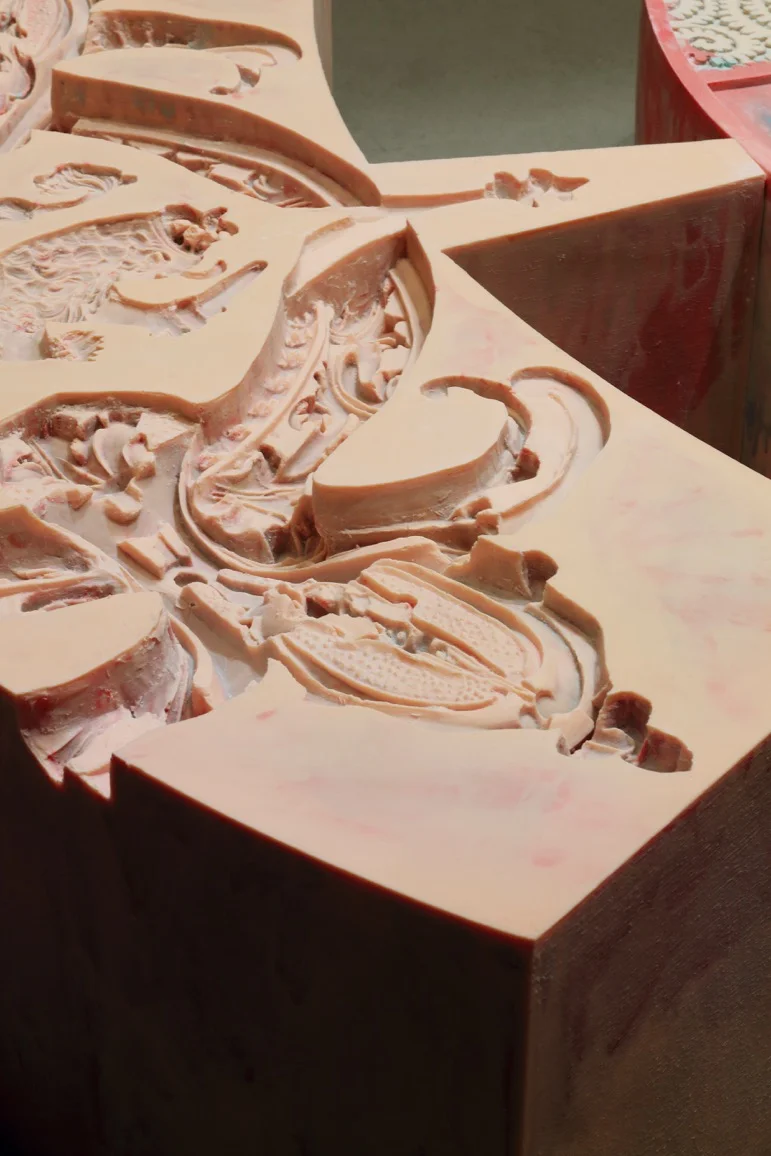Site specific work for the Tokyo Metropolitan Teien Art Museum in Japan
(text by the museum) Nynke Koster takes “molds” of interior pieces of historical buildings using a special rubber and creates from them sculptures on the border between art and design. Shifting the perspective and using unexpected material, a piece simultaneously serves as a functional object and a new autonomous work of art. This approach allows her to reinvigorate the decoration to a physical, tangible presence in space, and to re-appropriate the history of architecture with memories of those who once lived there. This year, she will participate in an upcoming group exhibition, Decoration never dies, anyway (November 18, 2017 to February 25, 2018) in the Tokyo Metropolitan Teien Art Museum, which is her very first in Japan. In September, she stayed in Tokyo for six weeks creates a new site-specific work especially for this exhibition. On this opportunity, she will introduce her unique approach with her previous works and her ongoing project in Tokyo.
Decoration has always existed together in hand with mankind. Beginning with rituals mourning the deceased and tattoos associated with sorcery, although on occasion rendered a mere formality, it is that which has continued to persist while repeatedly undergoing changes and harboring new meanings in correspondence to the times. Decoration could indeed be described as being constantly in flux, in an endless cycle of transmigration. This exhibition features seven artists whom are all different in age, nationality, and genre. The means of expression they employ are diverse, including a trailer adorned with Gothic decoration, carpets that mix together patterns derived from various cultural spheres, and paintings that through the façade of windows imagines the life and personalities of the people who live there. In their works the artists juxtapose entirely differ-ent epochs and values, imagine worlds that do not actually exist, and attempt to interpret the concept of “decoration” as it exists in the context of daily life. In observing their endeavors, we as viewers recognize that the act of decoration is indeed the essential key to perceiving the vivid and complex reality that inextricably surrounds us. After all, “Decoration never dies, anyway.”
Dejima and the Japanese window to Europe during the national isolation period.
Based on the mutual past between Japan and the Netherlands Dejima became a place of inspiration. Constructed in 1636, Dejima would later become a place where the Dutch East India Company would install a trading post, allowing the transport into Japan of both Western goods and the latest news of overseas current affairs. At the same time, Japanese goods, along with information about Japan, would be relayed to the West. During the long period of national seclusion (1641-1859), Dejima was the only door open to Europe and gave Nagasaki the status of Japan’s sole international trading port. Dejima played an important role in the development of culture, industry, and science in Japan by serving as a gateway to the West. Many ambitious Japanese scholars traveled to Nagasaki to study Rangaku (“Dutch learning”, i.e., Western science) including medicine, chemistry, weaponry, navigation, and astronomy. The fan-shaped artificial island of Dejima is restored to its 19th century state. To carry out this restoration, foundation stones, stone walls and many other remains were excavated and some are exhibited inside the carefully reconstructed buildings. The buildings were constructed using traditional Edo period method and installed European furniture based on early 19th century drawings of the island and models of Dejima’s buildings that are preserved in the Netherland. Other exhibitions, including the history of Dejima and Western learning and a miniature Dejima, provide visitors with a sense of everyday life on Dejima.




